Getting Started in FactoryTalk View ME HMI Development
HMI Development
HMI Development is often paired with PLC programming to visualize certain elements of a process controlled by a Programmable Logic Controller. A vast array of platforms and solutions are available to accomplish this task. However, in North America, FactoryTalk View Machine Edition is one of the most popular ways to build HMIs. This platform from Rockwell Automation allows users to create lightweight applications that run on stand-alone terminals branded as PanelViews. These terminals will come pre-configured to run a certain version of a FactoryTalk View application, communicate with one to multiple PLCs and require no additional hardware to display the information.
As mentioned above, the applications for PanelView terminals are created through FactoryTalk View Studio. That being said, it’s only one piece of the puzzle. The user is left to figure out how to build the application, transfer it to the terminal and how to retrieve it after it has been loaded onto one.
In this extensive tutorial, we will be going through the steps required to create a new FactoryTalk View ME application, transfer it to a terminal, retrieve it from the same and establish communications to an Allen Bradley CompactLogix PLC 1769-L24ER-QB1B.
Creating a New Application in FactoryTalk View Machine Edition
Start by launching FactoryTalk View Studio Machine Edition. Once the software loads, the user will be presented with a screen that allows them to work on an existing application or to create a new one. We will be creating a new application; click on the “New” tab at the top of the window.
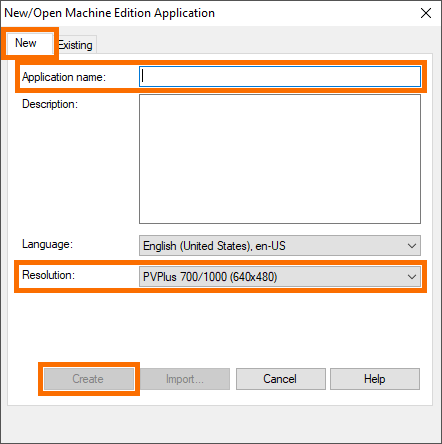
In this menu, you’ll have to specify a name for your application as well as the resolution. Note that the resolution will be based on your PanelView terminal. Different types will require applications of different resolutions. It is possible to run a smaller or larger application on a different screen, but the application will be distorted or be smaller than the screen; something to avoid.
Once you create a new application, FactoryTalk View Studio will take a moment to create all the tools and interfaces to edit the application.
Building an Application for a PanelView HMI Terminal
Before you start designing an application, it’s important to figure out which version of said application your terminal is capable of running. A specific version of FactoryTalk View Studio is capable of generating files of earlier versions. However, a PanelView terminal may only accept and run applications of the firmware it was flashed to. Finally, different types of PanelView terminals will be restricted to different versions of FactoryTalk versions.
Utilizing RSLinx Enterprise
If the target terminal is currently on the network, the user can find out the firmware through RSLinx. This software comes with the installation of FactoryTalk View as well as many other Allen Bradley packages such as RSLogix and Studio 5000. RSLinx is used as a networking tool and can be utilized to connect to the PLC and HMI systems in the field. An important difference between the regular installation of RSLinx and RSLinx Enterprise is that the Enterprise version will be accessible through FactoryTalk View Studio and run on the specific terminal.
From within the application you’ve created, follow the steps outlined below to add your terminal into RSLinx Enterprise.
1. Expand “FactoryTalk Linx” by clicking on the “+” sign
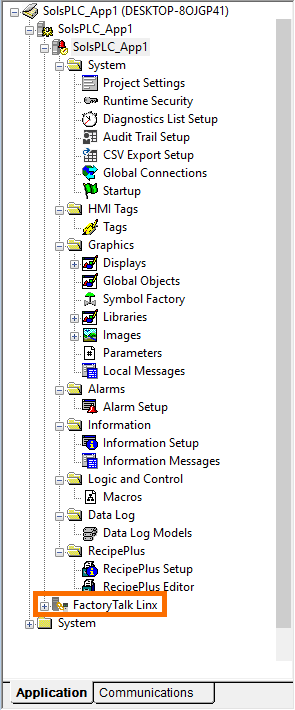
2. Double-click on “Communication Setup”.
3. Select “Create a new configuration”.
4. Press “Finish”.
5. Right-click on the top menu item and select “Add Driver”.
6. Select “Ethernet”.
7. Press “OK”.
At this point, your driver will be looking for the devices added to it. However, we haven’t added our terminal to this driver yet. In order to find out the version of the terminal, we must add it to the driver.
8. Right-click the new driver you’ve created.
9. Select “Add Device”.
10. Find the appropriate type of terminal matching the one you have in the field.
Note: In our case, the terminal is a “PanelView Plus 1000 Major Revision 3”.
11. Press “OK”.
12. Enter the IP address of the device.
Note: In our case, the terminal is at 192.168.1.20.
At this point, the terminal you’ve added to the driver should show up under the driver name. Note that it will not show up if it’s not actually connected to the same network as the laptop or the device is not at the specified IP address.

Although it’s showing in FactoryTalk View ME, we can’t see the version of the terminal here. To get this information, we will use a separate software which comes with the installation of FactoryTalk View Studio: ME Firmware Upgrade Wizard.
1. Launch the software.
2. Press “Next”.
3. Press “Next”.
4. Expand the driver you created previously by clicking the “+” sign.
5. Select the terminal you’ve added previously.
6. Press “Next”.
In the window in front of you should be the “Firmware version” of the terminal. This version will dictate which application type you can load onto this particular terminal. We will review this information once we create an executable HMI application in a future step.
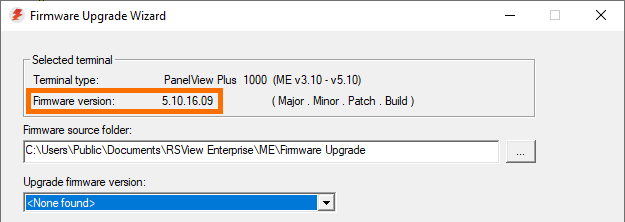
Creating a Runtime FactoryTalk View ME Application
At this point, the user should create the HMI application, program the tags and tie it to the PLC. We’re currently working on an extensive class that walks through the steps of building such an application. For the purpose of this tutorial, we’ve broken down a few basics.
Main Containers - Displays
Displays are the main components of an HMI application. They are used to display the control as well as data elements shown to the user. The first step in HMI programming is to create the displays used by the application. Typically, each application would contain a standard set of displays at a minimum: main screen, alarm screen, configuration or control screen and a settings screen.
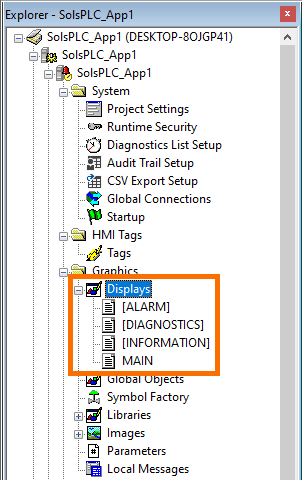
PLC to HMI - HMI Tags
An HMI will always connect to a field device in order to control field devices or display data sent to it. This requires the HMI to have a link to these devices. In the FactoryTalk View ME world, the HMI programmer has two choices: connect to the tags by directly specifying the address or by creating HMI based tags. Although direct addressing is fine for smaller applications, HMI Tags are the preferred way of communicating between the HMI and field devices in most cases.

Building the Final PanelView Terminal Application
Once the application has been developed, it’s critical to know how to transfer it to the PanelView terminal. This process isn’t as straightforward as one may think in the work of FactoryTalk View ME.
First, we need to create what’s called a Runtime application. A runtime application is an executable that will be transferred to the terminal and executed in the field.
1. Click on “Application”.
2. Click on “Create Runtime Application…”.
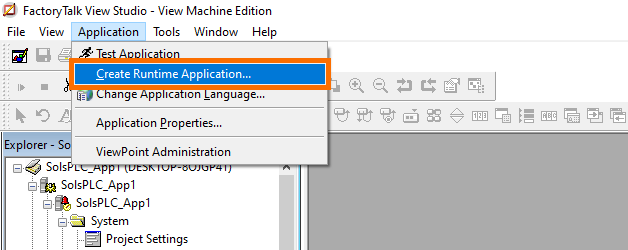
From the following menu, the user must select the version of the terminal this application will be used on. If it’s saved in an incorrect version, the terminal will not accept the application and the process will have to be repeated. Note that we've obtain this revision from the step above by looking at the properties of our terminal
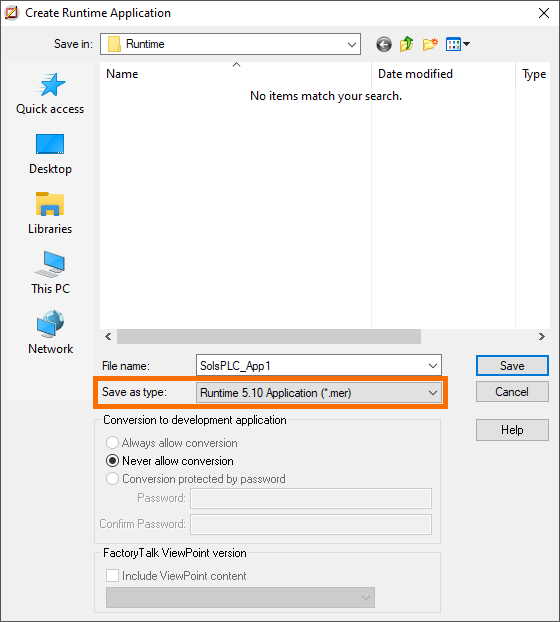
Notice that the runtime application will be of file type “.mer”. As you start working with FactoryTalk View Applications, there will be different files types you’ll have to be aware of. An application that is retrieved or is sent to a terminal, will always be of type “.mer”. An application that is shared between hosts would typically be of type “.apa”. We will see these two file types later in this tutorial.
Downloading a FTView ME Application to a PanelView Terminal
Now that we’ve created the application, we will have to use yet another piece of software to transfer it to the PanelView terminal: ME Transfer Utility. It comes with the installation of FactoryTalk View Studio and can be used to upload or download the applications from PanelView terminals.
1. Launch ME Transfer Utility.
2. Select the “Download” tab.
3. Expand the driver created above by clicking the “+” icon.
4. Select the HMI terminal you plan to transfer your file to.
5. In the “Source File” menu, click the “...” button.
6. Locate the runtime file you’ve created and press “OK”.
7. Select “Run application at start-up”.
8. Select “Replace communications”.
9. Select “Delete Log Files”.
10. Press “Download”
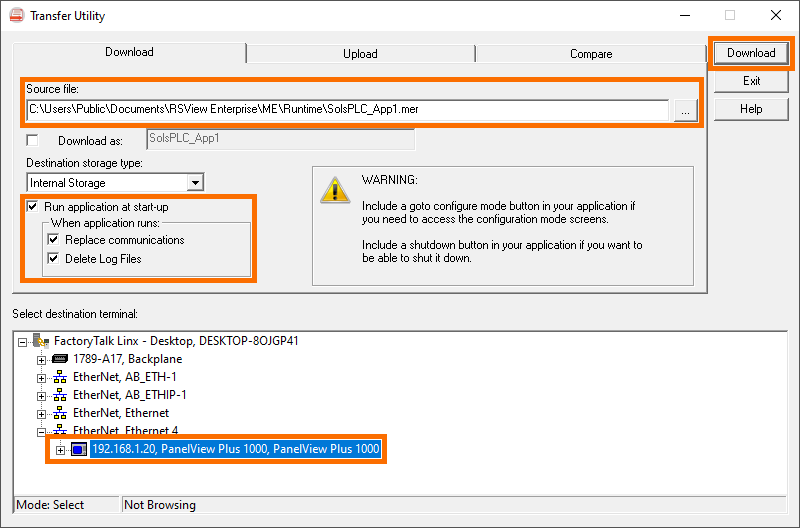
The ME Transfer Utility software will download the application you’ve created to the PanelView terminal. Once the download is complete, the terminal will reboot and launch into the application. You can start using your terminal for its intended purpose.
Uploading a FTView ME Application to a PanelView Terminal
Chances are, you will need to retrieve an application currently being used on a terminal for editing purposes. Generally speaking, a PLC or HMI programmer will have to modify more applications than create from scratch. In this section, we will show you how to upload applications that have been saved on a PanelView terminal.
1. Open ME Transfer Utility.
2. Navigate to the “Upload” tab.
3. Expand the driver created above by clicking the “+” icon.
4. Select the HMI terminal you plan to transfer your file to.
5. In the “Source File” menu, click the “...” button.
At this point, your application will connect to the terminal. It will allow you to choose one of the files currently stored on the PanelView for upload.
6. Select the file you wish to upload.
7. Press “OK”.
8. In the “Destination folder” menu, click the “...” button.
9. Select the folder for the file you will be downloading.
10. Press “Upload”.
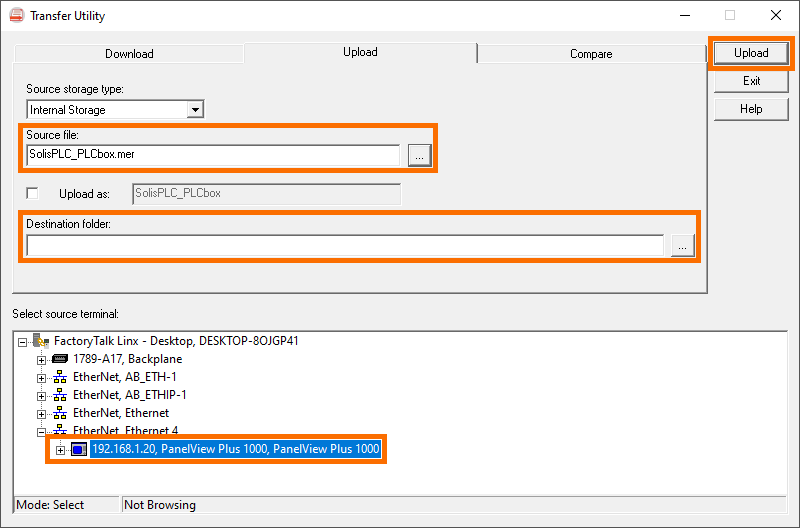
The application will save the target file on your PC. Note that this file will be of type “.mer”.
Converting a “.mer” File into a FactoryTalk View Studio Editable Application
Yet another software is required to migrate the file we’ve downloaded from the terminal into an editable FactoryTalk View ME application. This tool is called Application Manager and just like the others, comes installed with FactoryTalk View Studio.
1. Launch Application Manager.
2. Select “Restore runtime application”.
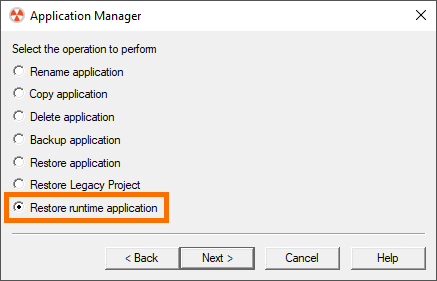
3. Press “Next”.
4. In the “Specify the runtime application to restore” field, click on the “...” button.
5. OPTIONAL - specify the password of the application.
6. Click “Next”.

The application will be restored into a FactoryTalk View ME application that the user may now launch from the main software package and edit.
Conclusion
Creating and deploying FactoryTalk View Studio Machine Edition HMI applications can be challenging due to a number of factors. There are multiple software packages you need to deal with, terminals aren’t straightforward to access and understand and the files have multiple types that make it confusing for new HMI programmers.


